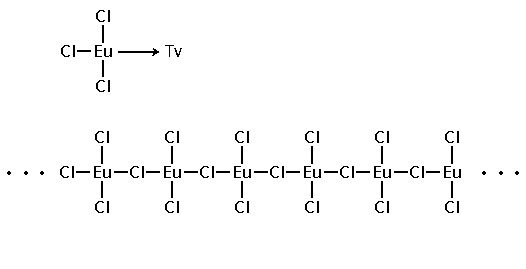Solid State
It is perfectly possible to carry out solid state calculations on lanthanide compounds and complexes.
As a first example, we shall calculate a linear chain of europium trichloride, something completely unreal and which does not exist. However, we will present this calculation merely as an example on how to carry out a one-dimensional solid state calculation of a polymer with a repeating structural unit.
In order to carry out a one-dimensional solid state calculation, we need to add one dummy atom Tv on the .mop input file. This Tv will define the translation vector that endlessly repeats the original structural unit along its direction, giving rise to the infinite one-dimensional chain, as indicated below:

Tv, indicates the point at the end of the translation vector, which is the distance through which all atoms must be moved (translated) in order to be in equivalent positions in the next unit cell.
The number of translation vectors, Tv, determines the type of infinite solid. A polymer has one Tv, a layer system has two Tv, and a solid has three Tv.
How to carry out a one-dimensional solid state calculation:
- Usually, the repeating unit is formed by one lanthanide complex. Please, make sure that the repeating unit has total charge zero. Otherwise, you will end up with an infinitely charged solid.
- As an example, let us consider a linear chain of EuCl3, as in the figure above.
- First draw and optimize the geometry of your repeating unit. Please, follow the instructions in Drawing Complexes. You should now have the corresponding .out and .arc files. As an example, we provide the EuCl3.mop.
- Locate the .arc file with the repeating unit optimized geometry. Now, convert this .arc file, EuCl3.arc, into an optimized .mop file, using your favorite text editor, as follows:
- Open the .arc file and save it with another name with the .mop extension.
- Find the line which reads FINAL GEOMETRY OBTAINED and remove everything above and including this line.
- Replace the keywords GNORM=0.2 and XYZ by keywords 0SCF and INT.
- Save the file as a .mop file with another name. For convenience we provide EuCl3-opt-int.mop.
- Run this new .mop file in MOPAC2012. This calculation transforms the cartesian coordinates into internal coordinates.
- Once again, convert the output .arc file, EuCl3-opt-int.arc, generated by MOPAC2012, into the optimized .mop file, using your favorite text editor, as follows:
- Open the .arc file and save it with another name with the .mop extension.
- Find the line which reads FINAL GEOMETRY OBTAINED and remove everything above and including this line.
- Replace the keyword INT by keyword XYZ.
- Save the file as a .mop file with another name. For convenience we provide EuCl3-opt-xyz.mop.
- Once again, run this new .mop file in MOPAC2012. This calculation transforms the internal coordinates back into cartesian coordinates. Moreover, the first atom is now placed at the origin of the cartesian coordinates and represents the starting point of the translation vector which ends in the dummy atom Tv.
- Now, we may run the solid state calculation.
- For the third time, we need to convert the .arc file, EuCl3-opt-xyz.arc, into the optimized .mop file, using your favorite text editor, as follows:
- Open the .arc file and save it with another name with the .mop extension.
- Find the line which reads FINAL GEOMETRY OBTAINED and remove everything above and including this line.
- Replace the keyword 0SCF by keyword GNORM=0.25 and add the keywords LET DDMIN=0.0.
- Add, in the last line, the dummy atom Tv and the Cartesian coordinates his. As show below:
AM1 SPARKLE XYZ AUX GNORM=0.25 CHARGE=0 Singlet LET DDMIN=0.0 Eu 0.00000000 +0 0.00000000 +0 0.00000000 +0 0.0000 Cl 2.30821782 +1 0.00000000 +0 0.00000000 +0 0.0000 Cl -1.15370668 +1 1.99915982 +0 0.00000000 +0 0.0000 Cl -1.15509586 +1 -1.99843319 +0 0.00000000 +0 0.0000 Tv 6.00000000 +1 0.00000000 +0 0.00000000 +0 - As the solid is a polymer, the Cartesian coordinates Y and Z of Tv are 0.000000, and fixed. So, the polymer is repeating itself along the X coordinate. Indeed, the X coordinate of Tv is the distance between the geometric centers of the two unit cells. At this point, the X coordinate value is a kick start of this distance.
- Besides each coordinate you will find either a +1 or a +0. A +1 indicates that the coordinate to its left is to be optimized. A +0 leaves the coordinate at its left in a fixed position. Since we want the polymer to repeat along the X coordinate, we will leave the Y and Z coordinates of Tv fixed, that is, with a +0 at their right.
- Save this file as a .mop file with another name. For convenience we provide EuCl3-opt-tv.mop.
- Run this new .mop file in MOPAC2012.
- The final optimized geometry of the polymer appears in the .arc file, as below:
FINAL GEOMETRY OBTAINED CHARGE AM1 SPARKLE XYZ AUX GNORM=0.25 CHARGE=0 Singlet LET DDMIN=0.0 Eu 0.00000000 +0 0.00000000 +0 0.00000000 +0 3.0000 Cl 2.31291176 +1 0.00000000 +0 0.00000000 +0 -1.0000 Cl -1.13215553 +1 1.99915982 +0 0.00000000 +0 -1.0000 Cl -1.13319787 +1 -1.99843319 +0 0.00000000 +0 -1.0000 Tv 5.96447067 +1 0.00000000 +0 0.00000000 +0
- For convenience we provide outputs files EuCl3-opt-tv.arc and EuCl3-opt-tv.out.